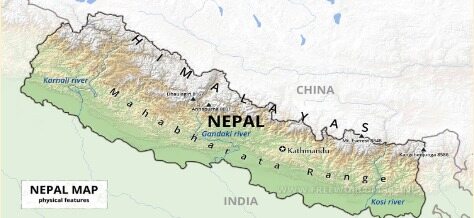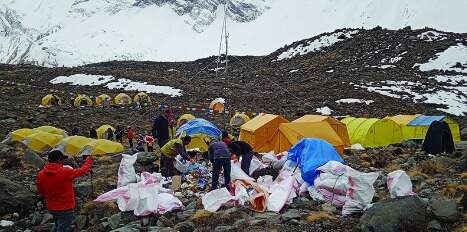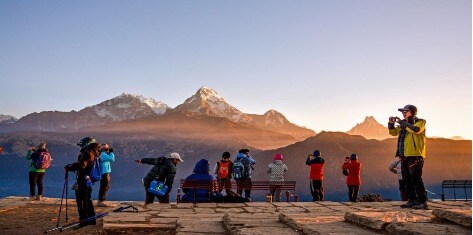Introduction
Nepal, a country nestled in the lap of the Himalayas, is a paradise for tourists from all over the globe. Known for its towering mountains, dense forests, and rich cultural heritage, Nepal offers a unique blend of natural beauty and historical significance.
Nepal has emerged as a popular destination for tourists from around the globe. The tourism industry plays a vital role in the nation’s economy, generating significant revenue and offering valuable employment opportunities. However due to increasing tourism Nepal is facing adverse environmental problems, it’s essential to understand the issue of trash and its greater impacts in the region.
Nepal Overview
Geography: Nepal is a sovereign country located in South Asia, surrounded by two neighboring countries: China in the north and India in the south. It is home to the majestic Himalayan mountain range, which includes the world’s tallest mountain, mount Everest. The country is divided into three geographical regions: the Himalayas, the Hills, and the Terai.
History: Nepal was earlier known as the Gorkha Kingdom, founded by King Gunkama Deva in 1723. Kathmandu, the capital city, was established in the same era and got its name from the wooden temple (Kath-Wooden, Mandu-Temple) that still exists in the city center. The government opened Nepal to tourists in 1950, leading to significant growth in the tourism sector.
Best time to visit: The summer holiday season, from April to June, is considered the best time to visit Nepal. However, if you’re interested in trekking on snowy mountains, the ideal time is from November to January.

Exploring The Wonders Of Nepal
- Kathmandu: The capital city is the most visited tourist destination in Nepal. Popular attractions include Swayambhu Maha Chaitya Stupa (Monkey Temple), Buddhanath Stupa, Durbar Square, Thamel Area, National Museum of Nepal, and Pashupatinath Temple.
- Pokhara: Known for its calm environment, Phewa Lake, adventure sports, and local markets, Pokhara is another popular tourist destination. Must-visit places include Phewa Lake, Davis Falls and Gupteshwar Caves, World Peace Pagoda, Pumdikot Shiv Temple, and Sarangkot Viewpoint.
- Lumbini: The birthplace of Lord Buddha, Lumbini is a sacred site for Buddhists. The temple houses the marker stone that indicates the exact spot of Buddha’s birth.
- Janakpur Temple: This temple is dedicated to Goddess Sita and is believed to be her birthplace. Made of white marble and white stone, the temple features colorful carved walls and is an important site for Hindus.
- Muktinath Temple: Situated in Mustang, this temple is a sacred site for both Buddhist and Hindu devotees. The temple offers a panoramic view of the North Side of the Tibetian Plateau and the Himalayan Range.
- Mt. Everest: Adventure enthusiasts can trek to the Everest Base Camp, which requires 14-15 days. The trek offers an opportunity to explore villages, restaurants, and shops along the way.
Nepal’s Climate Change: A Hidden Vulnerability
Nepal a small landlocked country in South Asia, is known for its rich biodiversity and unique geographical features, including the world’s highest mountain peak, Mount Everest. However, the country’s fragile environment is under threat due to climate change, which is exacerbating existing issues such as food and water security, conflict, and infrastructure development.
Climate change is a complex issue, and for countries like Nepal, it can easily get pushed to the back of the agenda due to more pressing and urgent concerns. Providing food to all citizens, addressing infrastructure issues, and improving the quality of life in remote communities are all significant challenges that require immediate attention.
The Conference of Parties (COP) is a significant event where global leaders gather to take action collectively to address climate change. In 2015, the creation of the Paris Climate Agreement set out to limit global warming to below 1.5 degrees Celsius, ideally, but definitely below 2 degrees Celsius. This agreement is crucial for countries like Nepal, which are already feeling the impacts of climate change.
A country emitting greenhouse gases doesn’t just impact that country; it impacts the entire world. Unfortunately, most of the greenhouse gas emissions historically have been produced by just a few wealthy, powerful countries. However, the impacts of climate change are not evenly distributed, and countries like Nepal, which have contributed very little to climate change, are likely to feel the biggest impacts.
To address this unfair distribution of the impacts and causes of climate change, funding mechanisms such as the climate adaptation fund and the recurring climate fund are essential. These funds can help countries like Nepal adapt to the impacts of climate change and build resilience.
It’s environment is under threat due to climate change, and it is crucial to address this issue to prevent further compounding existing problems. The Paris Climate Agreement is a significant step towards addressing climate change, but more needs to be done to ensure that the impacts of climate change are distributed fairly.
Funding mechanisms such as the climate adaptation fund and the recurring climate fund are essential to help countries like Nepal adapt to the impacts of climate change and build resilience. It is crucial that the international community supports countries like Nepal in their efforts to address climate change and build a sustainable future.
Understanding Frequent Earthquakes in Nepal
Nepal’s Seismic Setting
Nepal lies in a highly seismically active region, the Himalayas, which is the result of the collision between the Indian Plate and the Eurasian Plate. The collision has led to the uplift of the Himalayas, creating the highest mountain range in the world. The ongoing collision and convergence of the two plates have resulted in the formation of the Main Himalayan Thrust (MHT), a major fault zone that runs along the length of the Himalayas. The MHT is responsible for the frequent earthquakes in Nepal, as the collision and convergence of the two plates build up stress, which is released in the form of earthquakes.
The Gorkha Earthquake
On April 25, 2015, a magnitude 7.8 earthquake struck Nepal, causing widespread destruction and loss of life. The earthquake was centered in the Gorkha district, about 80 km northwest of Kathmandu, the capital city. The earthquake was the result of the rupture of the MHT, which released stress that had been building up for centuries. The earthquake caused significant damage to infrastructure, including the destruction of over 600,000 homes, and resulted in the loss of over 8,000 lives.
The earthquake was followed by numerous aftershocks, including a magnitude 7.3 aftershock on May 12, 2015, which caused further damage and loss of life. The aftershocks continued for several months, causing ongoing anxiety and fear among the population.
Impacts of the Gorkha Earthquake
The Gorkha earthquake had a significant impact on Nepal, causing widespread destruction and loss of life. The earthquake destroyed over 600,000 homes, leaving thousands of people homeless and displaced. The earthquake also caused significant damage to infrastructure, including roads, bridges, and schools. The earthquake caused over 8,000 deaths and injured over 21,000 people.
The earthquake also had a significant impact on Nepal’s economy, causing an estimated $10 billion in damages, equivalent to about 50% of the country’s GDP. The earthquake also had a significant impact on Nepal’s cultural heritage, causing damage to numerous historic buildings and monuments.
Nepal’s Seismic Future
Nepal’s seismic future remains uncertain, as the ongoing collision and convergence of the Indian and Eurasian Plates continue to build up stress along the MHT. The MHT is capable of producing earthquakes with magnitudes up to 8.5, which could cause widespread destruction and loss of life.
To address the threat of earthquakes, Nepal has implemented various measures, including the development of a national earthquake risk reduction strategy, the construction of earthquake-resistant buildings, and the establishment of an early warning system. However, more needs to be done to ensure that Nepal is prepared for future earthquakes.
Trash and Tourism In Nepal
Nepal is a country with incredible and captivating natural beauty. With tourism increasing in Nepal’s mountains, the limited amount of space available for landfills, and the role of the Himalayas as the water source for Southeast Asia, the impacts of trash pollution pose a significant threat to the environment and public health of the region.
Tourists generate significant amounts of solid waste, including trash and debris, which can pollute soil, lakes, streams, and groundwater. For example, a climber visiting Nepal’s Sagarmatha National Park, where Everest is located, can create around 8 kilograms of trash, most of which is left on the mountain. The Nepal Department of Tourism estimates that there are almost 140,000 tons of waste on Mount Everest alone. Tourists’ littering and microplastic pollution can exacerbate the ecological damage Mount Everest is already experiencing due to climate change.`
Because globalization is unavoidable and the number of tourists is expanding worldwide, the number of tourists in Nepal is increasing every year. As a result, more and more resources are consumed, resulting in a rise in waste and rubbish production. Even though storage bins and containers are placed alongside the walking trail in the Everest region with clearly written information about the bins, most tourists and porters do not follow the information and throw trash and waste wherever they want, which could be due to a lack of awareness among the public.
Tourists are a key part of this problem since the outcome will be determined by how they handle the situation. It depends on how they approach the waste management issue, how they respect the local community and diversity, and how they can support the local community by simply following the steps outlined in the walking trail for sustainable waste management.

Conclusion
Tourism impacts the economy but also the ways of living and the environment. This is the case of mountain tourism in general, and in particular, in Nepal. This dissertation contributed to the discussion of mountain tourism, highlighting the sustainability concerns based on the case study of Nepal tourism.
No one knows exactly how much garbage is on the mountain, but it is reaching important levels that may restrict the future equilibria of natural and social ecosystems, and then, the potential of the mountain as a tourism product. Glaciers are erupting with trash, while camps are overflowing with human garbage. Snow and ice are melting because of climate change, revealing even more waste that has been hidden for decades.
Tourists, the government, residents, the whole community, and social businesses, as well as the commercial sector, all play a vital part in keeping the name of the area good, ensuring Everest region sustainability, and making Nepal a more sustainable tourism destination. To address the environmental issues that have arisen in tourist destinations, mountaineers, locals, and the Nepal government must work together to solve the situation.
-ABHINASH AND BHAWNA
MUST READ: UNVEILING CHINA’S MASTERY: 7 STRATEGIES FOR GLOBAL DOMINATION





